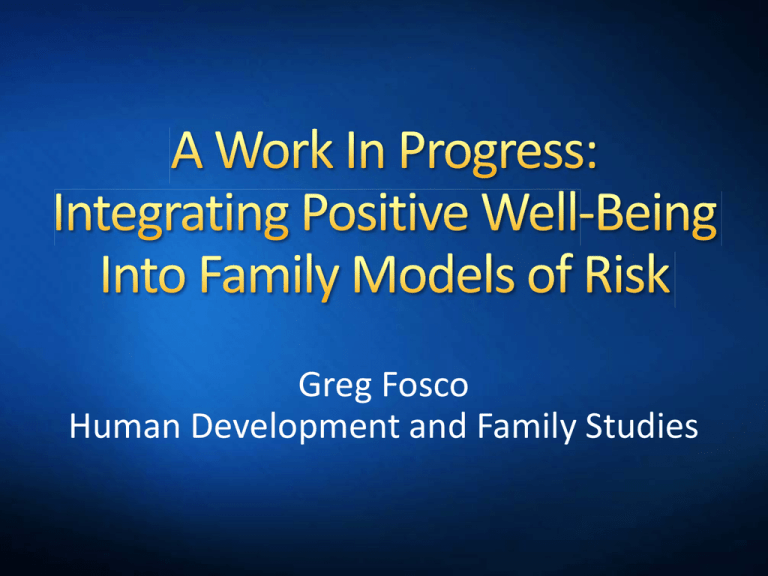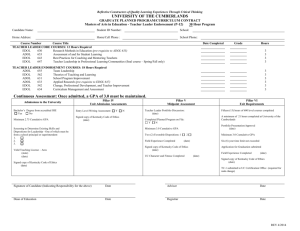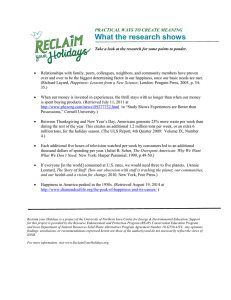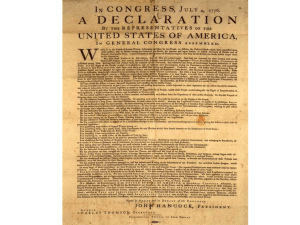Greg Fosco Human Development and Family Studies
advertisement

Greg Fosco Human Development and Family Studies Greg Fosco Grace Mak Mengya Xia A Brief Introduction Well-Being The Family Science of Well-Being FamilyCentered Intervention Basic Family Process Research Frequent, Intense, Unresolved, IPC Threat, Coping Child Psychopathology Self-Blame Fosco & Grych (2008) Fosco & Feinberg (In Press) Schlomer, Fosco, Cleveland, Feinberg, & Vandenberg (In Press) Family Context Interparental Conflict Self-Blame Threat, Coping Child Psychopathology Parent-child Relationships linked with appraisals and adjustment • Grych, Raynor, & Fosco (2004). Development and Psychopathology • Fosco & Grych (2010). Journal of Marriage and Family Warm, Sensitive Parenting linked with appraisals and adjustment • DeBoard, Fosco et al. (2010). Journal of Clinical Child and Adolescent Psychology Sibling Relationships linked with appraisals of parental conflict, well-being (beyond parent-child relationships • Grych, Raynor, & Fosco (2004). Development and Psychopathology Family Emotional Climate: Positive and Negative Expressiveness linked with appraisals of parental conflict, well-being • Fosco & Grych (2007). Journal of Family Psychology Chronic, Poorly Resolved Child Involvement In Conflict: Relationship Distress Parental Conflict For Parents: Triangulation Diversion from Conflict (Bell et al., 2001) Disrupted Development • Internalizing and Externalizing Problems • Unique mediator accounting for distress, threat, and blame • Impacts cognitive evaluations of IPC linked with risk outcomes • ↑ parent-adolescent conflict • ↓ parent-adolescent closeness • ↑ adolescent hostility • ↑ positive conflict resolution • ↑ verbal aggression Psychological Maladjustment Self-Blaming Attributions Disrupted Family Relationships Romantic Competence Grych, Raynor, & Fosco (2004) Fosco & Grych (2008) Fosco & Grych (2010) Fosco, Lippold, & Feinberg (2014) Fosco, Xia, & Grych (In Press) Emotional Climate SelfRegulation Interparental Conflict Parental Warmth, Sensitivity Fosco & Grych (2013). Journal of Family Issues Parenting Modules Parenting Information Initial Contact Family Assess Feedback Session Parent Groups Community Resources What family processes account for long-term outcomes and maintenance of intervention benefits? Participant motivation to change and engagement in interventions: patterns and implications. Gr. 6 Substance Use Path “B” Cigarette -.30* Alcohol -.22* Marijuana -.39* Gr. 7 s i B Gr. 6 SelfRegulation Gr. 7 SelfRegulation .08* Gr. 8 Problem Behavior Path “B” Antisocial Beh. -.12* Deviant Peer Affiliation -.18* FCU Group Fosco, Frank, Stormshak, & Dishion (2013), Journal of School Psych. Gr. 6 Gr. 7 Family Conflict i FCU Intervention Gr. 8 Family Conflict s Depression Antisocial Grade Grade 99 Depression Antisocial Grade Grade 66 Fosco, Van Ryzin, Stormshak, & Dishion (2014), Development & Psychopathology Fosco, Van Ryzin, Connell, & Stormshak (Under Review) Work with K. Bamberger & D. Coatsworth Fosco, Van Ryzin, Stormshak, & Dishion (2014), Development & Psychopathology 1. Subjective Well-Being 2. Family, SWB, and Beyond 3. Daily Family Process Models of SWB Affective: Frequent positive affect and infrequent negative affect Cognitive: The evaluation of one’s life as good Life Satisfaction Defined as distinct from Depression: i.e. a “reverse-scored” depression scale ≠ SWB ↓ Risky Sexual Beh. ↑Healthy ↓Violence Lifestyle Donohue et al., 2003 Suldo & Huebner, 2004 Valois et al., 2001 Valois et al., 2002 Valois et al., 2004 Valois et al., 2006 Zullig et al., 2005 SWB ↓ Obesity ↓Depression ↓Subst. Use ↓ Anxiety Longitudinal research on adolescent SWB is generally lacking (Proctor, Linley, & Maltby, 2009) SWB Psychopathology Low High Average to High Low “Positive Mental Health” 67% “Vulnerable” 8% “Symptomatic but Content” 17% “Troubled” 8% At equivalent risk for low GPA, and problematic teacher-student relationships (From: Antaramian, Huebner, Hills, & Valois, 2010) Keyes (2002; 2005; 2006) raised the question “Flourishing” based on criteria for subjective and psychological well-being Prevalence, Etiology, Course… N = 1234 Youth in the CDSII of the PSID Flourishing: 1 of 3 Hedonic Sx. 5 of 9 Psyc or Social WB Sx. Languishing: Low score on 1 Hedonic Sx. Low score on 5 Psyc/Social SX 60 54.5 48.8 50 45.2 39.9 40 30 20 10 6 5.6 0 12 to 14 Year Olds Languishing 15 to 18 Year Olds Moderately Mentally Healthy Fourishing From Keyes (2006) Quality of Life 88 86 84 82 80 78 76 74 72 70 68 66 64 62 60 58 56 54 52 50 48 46 44 42 40 Sample 11 12 13 14 Adolescent Age 15 16 (Goldbeck et al., 2007) Quality of Life 92 90 88 86 84 82 80 78 76 74 72 70 68 66 64 62 60 58 56 54 52 50 48 46 44 42 40 Male Female Sample 11 12 13 14 Adolescent Age 15 16 (Goldbeck et al., 2007) Mean i = 5.44* s = - .04* Std. s = -.30 Sample and Estimated Means VAR: i = 0.62* s = - .02* Individual Estimated Curves Unconditional LGCM: χ2(5) = 4.938, p<.42; CFI = 1.00, TLI = 1.00, RMSEA = .00 Mean i = 5.02* s = - .07* Sample and Estimated Means VAR: i = 0.40* s= - .04* Individual Estimated Curves Unconditional LGCM: χ2(5) = 8.503, p<.13; CFI = 1.00, TLI = .99, RMSEA = .03 Appears to be distinct from mental health indices in terms of risk Unique risk group – low symptoms and low SWB Developmental Trends: Decreasing during early adolescence Considerable individual differences in trajectories Unique pathways to SWB (accounting for maladjustment) Long-term benefits of SWB for adolescents Family Factor A Psychopathology Family Factor B SWB Family Factor C Self Regulation Age 22 Family Functioning Age 17 C O F M Family Conflict Family Cohesion EC Young Adult Adaptation Age 23 Aggression Depression O C F M SWB Fosco, Caruthers, & Dishion (2012). Journal of Family Psychology Fosco & Feinberg (In Press). Development and Psychopathology Yes! Common risk/promotive factors Lingering question…. Are there unique family factors for SWB? Parent Engagement with Adolescent Adolescent Affect & Evaluation of Life Psychological Adjustment Problems Emotional Distress Problem Behaviors Do developmental trajectories of SWB correspond to parent-adolescent engagement? Is this a reciprocal process? Drawn from a community implementation of the PROSPER intervention delivery system in rural Iowa and Pennsylvania. Sample = 970 early adolescents and caregivers 49.5% Female, 84% Caucasian Five Waves: Fall 6th, Spring 6th, 7th, 8th, 9th Grades Adolescent, mother, father data from in-home assessments Parent Hostile Engagement: negative affective quality scale (Spoth, Redmond, & Shin, 1998) Life Satisfaction Scale: Mental Health Inventory-38 (Viet & Ware, 1983), enjoyment of life, feeling happy and hopeful about the future. Subjective Happiness Scale (Lyubomirsky & Lepper, 1999), general happy mood and disposition. Emotional Distress: Depressed/Anxious Scale, YSR Problem Behavior: Externalizing Scale, CBCL/YSR Unconditional Growth Models Bivariate Growth Models Parent engagement and adolescent SWB: changing in related manner? Hybrid Models – capturing latent trajectories and bidirectional associations Direction of effects Timing of effects Mean i = 5.44* s = - .04* Std. s = -.30 Sample and Estimated Means VAR: i = 0.62* s = - .02* Individual Estimated Curves Unconditional LGCM: χ2(5) = 4.938, p<.42; CFI = 1.00, TLI = 1.00, RMSEA = .00 Mean i = 5.02* s = - .07* Sample and Estimated Means VAR: i = 0.40* s= - .04* Individual Estimated Curves Unconditional LGCM: χ2(5) = 8.503, p<.13; CFI = 1.00, TLI = .99, RMSEA = .03 Model Fit: χ2(5) = 81.97, p<.01; CFI = .96, TLI = .95, RMSEA = .03 Means: i = 2.498 (p<.01), s = -.11 (p<.05) Variance: i=.50, p<.01; s=.01, p<.01 Bivariate Growth Models: Sample W1 Adol. Happiness W2 Adol. Happiness Initial Level W3 Adol. Happiness W4 Adol. Happiness Slope Are initial levels correlated? Are rates of change (slope) correlated? Initial Level W1 P-C Neg. Eng. W2 P-C Neg. Eng. Slope W3 P-C Neg. Eng. W4P-C Neg. Eng. Bivariate Growth Models: Are the Trajectories Related? Model Correlation Intercepts Correlation Slopes PC Negative Engagement and Adol. Happiness -.46** -.37** PC Negative Engagement and Adol. Life Satisfaction -.49** -.40** Initial Level Slope W1 Parent W2 Parent W3 Parent W4 Parent Hostility Hostility Hostility Hostility W1 Adol. Happiness Model Fit: χ2(13) = 17.03, p<.20 CFI = .99, TLI = .99, RMSEA = .02, SRMR .02 -.06* -.06* -.08* χ2(1) = 0.74 p = ns -.03 -.09* -.14* χ2(1) = 5.46 p < .02 W3 Adol. Happiness W4 Adol. Happiness W2 Adol. Happiness Initial Level Slope Initial Level Slope W1 Parent W2 Parent W3 Parent W4 Parent Hostility Hostility Hostility Hostility -.05* -.06* -.08* χ2(1) = 3.45 p = ns -.03* -.15* -.22* χ2(1) = 14.35 p < .01 W1 Adol. W2 Adol. W3 Adol. W4 Adol. Life Sat. Life Sat. Life Sat. Life Sat. Model Fit: χ2(13) = 24.64, p<.05 CFI = .99, TLI = .99, RMSEA = .03, SRMR .02 Initial Level Slope Happiness Model: Predicting Adjustment Initial Level W1 Behavior Problems Slope .14* .15* W1 Parent W2 Parent W3 Parent W4 Parent Hostility Hostility Hostility Hostility W1 Adol. Happiness Model Fit: χ2(31) = 57.11, p<.05 CFI = .99, TLI = .99, RMSEA = .03, SRMR .02 W2 Adol. Happiness W3 Adol. Happiness W5 Behavior Problems W4 Adol. Happiness W5 Distress -.20* Initial Level -.30* Slope W1 Distress Happiness Model: Predicting Adjustment Initial Level W1 Behavior Problems Slope .34* W1 Parent W2 Parent W3 Parent W4 Parent Hostility Hostility Hostility Hostility W1 Adol. Happiness Model Fit: χ2(31) = 57.11, p<.05 CFI = .99, TLI = .99, RMSEA = .03, SRMR .02 W2 Adol. Happiness Initial Level W3 Adol. Happiness W4 Adol. Happiness .05 W5 Behavior Problems W5 Distress Slope W1 Distress Happiness Model: Predicting Adjustment Initial Level W1 Behavior Problems Slope W1 Parent W2 Parent W3 Parent W4 Parent Hostility Hostility Hostility Hostility W1 Adol. Happiness W2 Adol. Happiness W3 Adol. Happiness W4 Adol. Happiness W5 Behavior Problems -.17* W5 Distress -.47* Model Fit: χ2(31) = 57.11, p<.05 CFI = .99, TLI = .99, RMSEA = .03, SRMR .02 Initial Level Slope W1 Distress Happiness Model: Predicting Adjustment Initial Level W1 Behavior Problems Slope .34*..14* .15* W1 Parent W2 Parent W3 Parent W4 Parent Hostility Hostility Hostility Hostility W1 Adol. Happiness Model Fit: χ2(31) = 57.11, p<.05 CFI = .99, TLI = .99, RMSEA = .03, SRMR .02 -.06* -.09* -.13* -.05* -.17* -.25* W3 Adol. Happiness W4 Adol. Happiness W2 Adol. Happiness W5 Behavior Problems .05 -.17* -.47* -.30* -.20* Initial Level .57* W5 Distress .21* Slope W1 Distress Life Satisfaction Model Initial Level W1 Behavior Problems Slope .32*..17* .20* W1 Parent W2 Parent W3 Parent W4 Parent Hostility Hostility Hostility Hostility W1 Adol. Life Sat. Model Fit: χ2(31) = 57.11, p<.05 CFI = .99, TLI = .99, RMSEA = .03, SRMR .02 -.06* -.07* -.10* -.04* -.17* -.25* W2 Adol. Life Sat. W3 Adol. Life Sat. W4 Adol. Life Sat. W5 Behavior Problems .01 -.22* -.39* -.26* -.12* Initial Level .61* W5 Distress .23* Slope W1 Distress Substance use trajectories: might SWB have unique implications beyond maladjustment? Overall, negatively correlated (cross-sectional) Interesting: some findings for SWB and increases in alcohol use Secondary Data Analysis Grant with PROSPER Timing of Substance Use Initiation Whole Family Conflict, Cohesion Adolescent SWB Maladjustment Interparental Conflict Effective Parenting & Involvement Middle School, Grades 6-8 Substance Use Problems Adjustment Problems High Risk High-Risk HighSexual Beh Beh. Grade 9 Early Adulthood Family Relationships Parent-Adolescent Daily Mood, Satisfaction Reactivity: the magnitude of emotional arousal in response to an event E.g., comparing negative affect on days when conflicts occur vs. no-conflict days Residue: the degree to which arousal persists beyond the conflict event E.g., negative affect on subsequent days, An opening into the family processes that elicit and maintain positive affect on a daily basis E.g., Positive affect reactivity and residue to parental support Support reactivity to child positive affect Mapping daily reactivity and residue to longterm indicators of adjustment Evaluating family contextual factors for reactivity and residue Global Contextual Factors FamilyParentLevel Adolescent Functioning Rel. Qual. Parent WellBeing SocioEconomic Disadvantage Global Indicators Emotional Distress Family Rels. Parent-Adol. Positive Reactivity, Residue Problem Behaviors Social Competence Academic Achievement gmf19@psu.edu gregfosco.weebly.com







